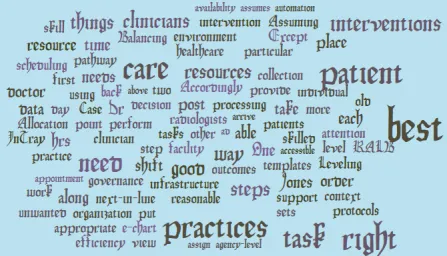Patient- Centered Care – Basic EHR Needs
Blog: KWKeirstead's Blog
When I was a child, our family doctor did house calls. Visits were particularly remarkable during snowstorms when the good doctor would arrive with horse and sleigh.
We will never get back to the “good old days” but it is worth documenting the essentials of patient-centered care within the context of today’s “healthcare factories”, where things have, in my view, gone over the edge.
The first requirement is that your home doctor have an EMR.
This is nothing more than an electronic version of the old paper-chart except that it is more accessible and the information can be shared. Assuming inter-operability, that is.
The purpose of the e-chart is unchanged relative to its paper chart precursor. The default view remains a reverse chronological record of interventions, each with a date/timestamp and performing resource “signature”. If you click on a hyperlink, a reasonable expectation is to be able to see data, as it was, at the time it was collected, on the form versions that were in service at that time.
The reasons for consulting the e-chart are to determine what the most recent intervention was and provide decision support in respect of the current and future interventions.
One way to simplify decision support is to put in place “best practice” protocols to guide the processing of patients.
Clinics/hospitals need best practices templates, with facilities for streaming patients onto private instances of these templates. Each template needs to consist of an orderly sequence of steps/interventions, with instructions at steps, context-situational appropriate data collection forms and routing parameters that indicate the required classes of users with the skill sets to perform steps.
The logic for “best practices” is that there cannot be 10 best ways to manage a patient with a set of symptoms/signs and a somewhat similar history of interventions.
Except that rigid imposition of protocols (i.e. cookie cutter medicine) does not work.
Accordingly, clinicians must have the freedom to deviate from best practices. This means “best practices” become guidelines and the care environment needs to be able to provide governance to prevent extreme, unwanted deviations from the “best practices”. Rule sets at the Case level are capable of taking care of this.
So, with the above infrastructure in place (i.e. guidance and governance), the clinic/hospital is in a position to do the right things, the right way, using the right resources. Assuming, inter-operability.
What’s missing?
Well, two things.. Location and Timing.
No point scheduling an intervention that needs a particular piece of equipment or a particular skill when the organization has neither. And, for good outcomes, we need timely interventions, which assumes availability of infrastructure and availabiliy of skilled resources.
For this reason, patient care systems need RALB (Resource Allocation, Leveling and Balancing) that take best practice steps and ad hoc interventions and assign these to specific healthcare professionals. (Dr. Jones, in Examination Room 307, with Patient Martha Bloggs, on Friday 16th 2015 at 1000 hours).
Clearly, in a facility with various teams of skilled resources we need tasks to post to the attention of “day shift radiologists”, not Dr. Jones.
The way RALB works is to post the “next” step along a patient care-pathway to the attention of “day shift radiologists” and if there are, say, three of these on shift, the first to “take” the order “owns” the step and is expected to perform it or put it back in the resource pool.
If Dr. Jones takes the order, he/she needs to be able to micro-schedule the order in the context of other time demands, so a 1000 hrs scheduled appointment could start at 1025 hrs, or 1045 hrs, but the point is the task does not fall between the cracks.
In a large facility, there may be schedulers who offload work from clinicians to other clinicians, so we end up with 3-tier scheduling (allocation, leveling, balancing).
It’s not enough to be efficient in the processing of individual steps along patient care pathways.
On top of this, organizations need to ensure that as one task along a patient care pathway is complete, the next-in-line task will take place without unwanted delay.
So, given a Case Management environment, tasks post to clinician InTrays, then, following completion of a task, that task clears from the InTray of the clinician who “took” the task and the next-in-line task as per the flowgraph template instance posts to the InTray of the appropriate clinicians.
Now, the organization is doing the right things, the right way, using the right resources, at the right places and at the right times.
There are two faults with the “best practices” focus.
One is that efficiency at the individual patient care pathway level does not necessarily lead to overall agency-level efficiency. Accordingly, it’s reasonable to expect overrides to best practices “for the greater good”.
A second fault with “best practices” is that effectiveness will be decreased by overhead related to regulatory “long term outcomes” data collection.
We need to look to automation to minimize the impact.
Filed under: Case Management, Data Interoperability, Decision Making, FIXING HEALTHCARE Tagged: #CostOfHealthcare, Case Management